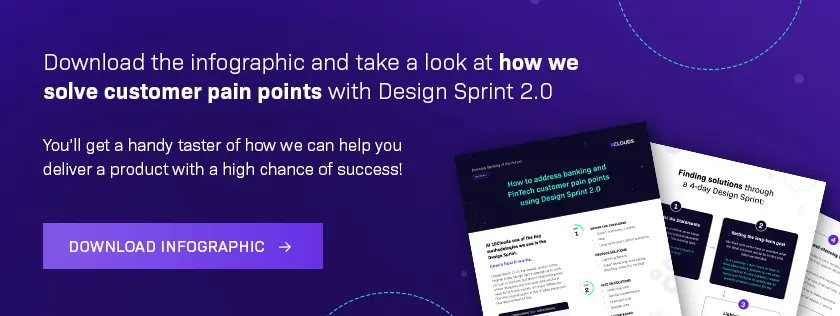Addressing Banking Customer Pain Points with Design Sprints
26.11.2021 | 2 min read

An example of a ready-to-implement digital product concept delivered in just 4 days
As a FinTech and blockchain software development company, we often have clients come to us with an idea that’s already well-developed, with extensive market research conducted and a thorough go-to-market plan. However, we also have clients who are at a much earlier stage in their journey. They have a problem that they know is very pertinent, or they’ve spotted a gap in the finance market, and they need support in figuring out what their solution should look like. Here’s where using Design Sprint 2.0 can be really effective. We’ll tell you why.

Why choose Design Sprint 2.0?
The major benefit of adopting the Design Sprint 2.0 methodology is the speed in which decisions are reached. This type of work cuts through the unnecessary admin generated by some other UX processes such as:
- Many separate presentation decks and documents
- Several rounds of feedback and resulting new interactions
- Delays in getting approval from senior decision-makers
Design sprints bring all the relevant people together for four days of uninterrupted work, and, importantly, all decisions are made right there and then. There are tangible benefits not just for designers, but for all stakeholders in the projects.
Aside from speed, teamwork is another major benefit of the Design Sprint 2.0 approach. Stakeholders who would have otherwise been absent for most of the design process, are now able to actively take part.
Using the Design Sprint to address an SME banking pain point
The context: Companies of all sizes often seek various solutions in their foreign-trade-related business activities. Yet only a small part of what they need is provided by financial institutions.
The pain point: The lack of broader provision for SME foreign exchange, and the fragmentation of these foreign trade services makes conducting international business much more complex.
The challenge: To analyze foreign trade activity and explore solution(s) that support businesses, connect fragmented tools and platforms, improve speed and lead to better ways of conducting business across borders.
Find out how our Design Sprint worked in practice
Our Design Sprint took place over four days and involved eleven senior finance experts who are part of our Banking of the Future Think Tank. We went through all stages of the sprint from making ‘How Might We Statements’ through to coming up with the final challenge to solve, all the way to prototyping and even user testing.




